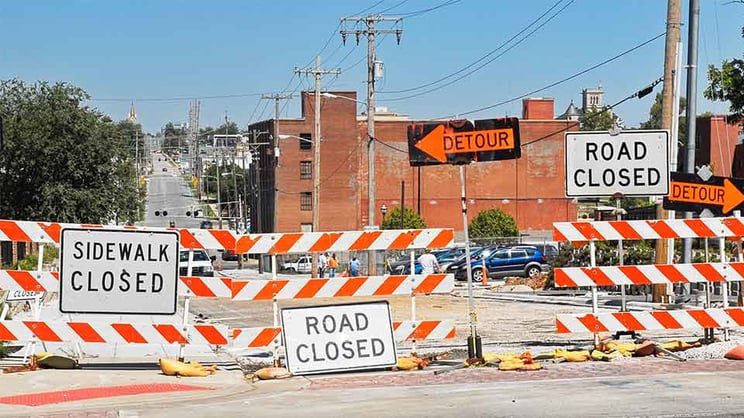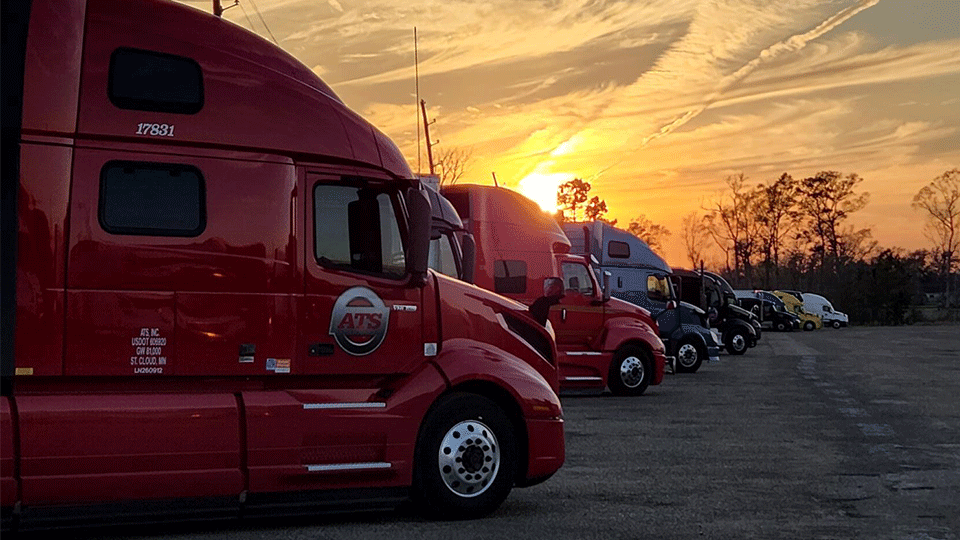Key Takeaways:
- Hurricane season (June-Nov.) disrupts freight with port closures, flooding, capacity shortages, and rate spikes.
- Plan ahead with backup routes, diverse carriers, solid insurance, and real-time tracking.
- Stay in sync with providers through clear communication and visibility tools.
- Review after storms to refine contingency plans and strengthen resilience.
As hurricane season ramps up along the Atlantic and Gulf Coasts from June through November — typically peaking around mid-September — freight shipments can face severe delays, infrastructure challenges, and rising costs.
Anderson Trucking Service (ATS) has been in the transportation industry for seven decades, so we've seen our fair share of shippers through hurricane season, winter storms, and other severe weather events.
This guide is an extension of that work, designed to arm shippers like you with proactive tactics to keep your supply chain resilient — especially across vulnerable U.S. logistics hubs like Texas, Louisiana, the Carolinas, and Florida.
While severe storms are never fully predictable, with some expert guidance, pre-planning, and an eye on the sky, you can keep your freight moving safely and on time during this tumultuous season. Let's get into it.
Hurricane Season Fast Facts: Your Top Questions, Answered
Before we address the critical risks of shipping during hurricane season in the U.S., here's a quick overview of the high-level facts.
When is hurricane season in the U.S.?
According to the National Oceanic and Atmospheric Administration (NOAA), the official hurricane season for the U.S.'s Atlantic basin spans June 1 to November 30.
When is peak hurricane season?
The U.S.'s hurricane season peaks around September 10, with most hurricane and tropical storm activity occurring between mid-August and mid-October.
What are the top states for hurricanes?
The top five states most commonly struck by hurricanes according to NOAA landfall data are:
- Florida
- Texas
- Louisiana
- North Carolina
- South Carolina
While states like Mississippi, Alabama, and Georgia are still at risk for hurricanes, they are statistically less likely to experience landfalls due to their comparatively shorter coastlines.
How dangerous are hurricanes to truckers?
Hurricanes and other extreme weather events can pose significant dangers to truck drivers due to a combination of factors, including the size of their vehicles, poor visibility, wet or flooded road conditions, and high winds.
A 1997 analysis of large truck fatal crash data collected through the National Highway Traffic Safety Administration's (NHTSA) Fatality Analysis Reporting System (FARS) indicated that adverse weather conditions were present during 25 percent of all speeding-related multi-vehicle large truck fatal crashes and 15 percent of non-speeding related multi-vehicle large truck fatal crashes.

Freight Shipping Risks During Hurricane Season
From flooded highways and closed ports to driver shortages, hurricanes can disrupt your shipping operations, inflict costly damage to your freight, and cause a ripple effect that reaches far beyond the storm's landfall.
As a shipper, understanding these risks is the first step toward building resilience. By knowing what challenges to expect, you can prepare your freight strategy to withstand disruptions and keep critical cargo moving, even in the most turbulent conditions.
Here are some of the potential risks you may encounter if you're shipping during hurricane season this year:
- Port closures and restrictions: Gulf and East Coast ports often suspend operations during severe storms, which could delay cargo until the danger has passed.
- Highway and rail disruptions: Flooding, debris, and infrastructure damage can delay or reroute ground transportation.
- Capacity shortages: Drivers may be avoiding affected areas or pulled into FEMA or relief efforts, tightening available freight capacity.
- Rate volatility: Sudden demand spikes for limited truck capacity can cause sharp increases in freight costs.
- Risk of cargo damage: Rain, wind, and power outages increase the risk of damage to temperature-sensitive or high-value freight.
- Communication breakdowns: Outages and limited visibility may make it harder to track shipments and stay informed.
While these risks can’t be eliminated, they can be anticipated and managed. By taking proactive steps before hurricane season peaks, shippers can reduce delays, protect cargo, and keep supply chains moving.
Proactive Freight Shipping Strategies for Hurricane Season
The risks of hurricanes are significant, but you don’t have to be caught off guard. The key is turning awareness into action.
By implementing proactive strategies like contingency route planning and carrier network diversification, you can minimize disruption and safeguard your supply chain.
These steps not only reduce the immediate impact of a storm but also strengthen long-term resilience for future hurricane seasons.
Risk Management & Disaster Recovery Planning
The first line of defense against hurricane-related supply chain disruptions is a solid risk management plan.
And you don't have to do it alone, nor should you: the experience of a transportation provider is an invaluable resource to lean on as you develop your contingencies.
Just as you bring a deep understanding of your business and supply chain to the conversation, your provider will bring its knowledge of its fleet or network. Together, you can build out a plan that anticipates disruptions rather than simply reacting to them.
Here are some strong places to start your risk management and recovery discussions with your transportation provider:
- Perform a vulnerability assessment: Determine the highest-risk pinch points in your supply chain by mapping out which facilities, lanes, ports, and suppliers are located along the Gulf and Atlantic coasts
- Scenario planning: Run “what if” exercises (e.g., what if a major port closes for a week?) and document backup shipping paths, storage options, and resource allocations.
- Clarify your communication plan: Define your protocols. Who will be the point of contact in an extreme weather scenario? How often will updates be shared, and through what channels?
By mapping out your vulnerabilities and potential disaster recovery scenarios, you’ll know exactly how freight can be rerouted or delayed during severe weather.
This preparation ensures your team isn’t reacting in the moment, but executing a strategy designed to minimize losses and restore operations quickly.

Build Supply Chain Resilience: Diversify Carriers & Routes
The most resilient supply chains are proactively designed to absorb shocks — and hurricane season can certainly bring plenty of shocks to shippers.
Hurricanes can shut down entire ports, strain carrier capacity, and reroute equipment for government relief efforts. And if you're dependent on a single provider or mode, your freight could be stranded with limited alternatives, leading to delays.
A resilient supply chain anticipates these challenges by diversifying suppliers, spreading inventory across multiple warehouses, and building in safety stock where possible.
Diversifying your carriers and planning alternate routes will fortify your hurricane freight shipping strategy. Establishing relationships with multiple trusted carriers can do three key things for your business during peak hurricane season:
- Increased access to capacity: When equipment tightens after a storm, a broader carrier base improves your chances of securing trucks or containers.
- Expanded routing options: Multiple carriers give you access to different ports, lanes, and terminals, making it easier to reroute shipments when closures occur.
- Strengthened resilience: With backup providers in place, your supply chain can continue moving freight even if one carrier is down or overcommitted.
No matter what your freight network looks like, mapping out alternative routes that include secondary ports, rail options, or inland cross-dock facilities will allow you the flexibility to keep freight moving even when primary lanes are closed or over capacity.
By creating this network diversity and redundancies, you’ll ensure critical shipments still reach their destination — even if part of your supply chain goes offline during a hurricane.
Fortify Cargo Insurance Coverage
If there's one lesson we've learned about cargo insurance policies, it's this: never assume. Unfortunately, your standard freight coverage may not fully protect shipments exposed to hurricane conditions.
Review your cargo insurance policies ahead of peak season to confirm that flooding, wind, and business interruption risks are included. You may need to add policies or upgrade your existing coverage to ensure your freight is covered in case of extreme weather.
A comprehensive insurance plan will go a long way toward offsetting financial losses if shipments are delayed, rerouted, or damaged during the storm.
Use Real-Time Visibility Tools
When storms are moving quickly, visibility is essential.
Transportation management systems (TMS) and real-time tracking platforms provide up-to-date insights into where freight is located and how weather may affect delivery. Coupled with automated alerts, these tools empower shippers to make fast, informed decisions during rapidly changing conditions.
Make sure your TMS, order management, and communications tools are all updated and cloud-backed before shipping anything during hurricane season. This will allow operations to continue even if a physical site is down due to storm-related complications and ensures your customers will receive timely updates on delays or reroutes.
You should also be talking with your providers about their capabilities in advance of any hurricane season shipping. Here are three key questions to ask about your freight carrier's extreme weather preparedness:
- Will I be able to track my freight in real time during a disruption?
- How quickly will I be notified if my shipment is delayed or rerouted?
- Who is my dedicated point of contact during a storm response?
Of course, even with strong visibility and communication in place, the real test comes after the storm, when it’s time to assess the damage, restore operations, and strengthen your supply chain for the next hurricane.
Conduct a Post-Hurricane Review
Once any immediate disruption to your shipping operations has passed, recovery efforts begin. This stage is about more than just getting freight moving again — it’s an opportunity to evaluate how well your strategy worked and where adjustments are needed.
A thoughtful post-event review not only accelerates recovery but also builds long-term resilience for future storm seasons. Here's a quick checklist of key items to cover in your review:
- Evaluate shipment performance: Compare planned vs. actual transit times to pinpoint where disruptions were most severe.
- Assess carrier reliability: Review how quickly each carrier responded, communicated, and recovered capacity after the storm.
- Document costs and claims: Track rate increases, detention fees, and any cargo loss or insurance claims to measure financial impact.
- Review communication effectiveness: Analyze how well updates were shared with your team and your customers, noting where and why breakdowns occurred.
- Identify supply chain bottlenecks: Highlight vulnerable facilities, ports, or routes that delayed shipment progress or slowed recovery the most.
- Update contingency plans. Use lessons learned to refine alternate routes, capacity commitments, and escalation protocols.
- Strengthen relationships: Debrief with providers and customers to discuss improvements and reinforce preparedness before the next storm season.
By reviewing shipment data, carrier performance, communication effectiveness, and customer feedback, shippers can identify both strengths and gaps in their hurricane strategy.
Hurricane Season Shipping Preparedness: Building Resilience for the Future
Hurricane season will always bring uncertainty, but it doesn’t have to bring chaos to your freight network. Proactive planning can make all the difference to your supply chain when hurricane season (or any other seasonal inclement weather) rolls around.
At ATS, we know that firsthand. Our decades of experience guiding shippers through hurricane seasons, winter storms, and other supply chain disruptions have shown us that each storm offers valuable lessons — and if you take the time to review and refine your strategy, you’ll come back stronger the next time severe weather strikes.
By anticipating risks, diversifying carriers and routes, strengthening insurance coverage, and investing in real-time visibility, shippers can stay ahead of disruption and protect critical cargo.
Ready to safeguard your supply chain this hurricane season? Connect with our team today to build a customized freight strategy that keeps your shipments moving no matter what the forecast holds.




